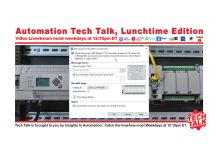
While Rockwell’s Micro800 family of low cost programmable controllers have appealing price points, one look at the programming software is often enough to keep many Logix users away.
But when you have a truly small system, the fact that the Micro800 is so much less expensive than the CompactLogix, and that the MicroLogix 1000 and 1500 are obsolete, there’s a case to be made for learning more about the Micro800.
At first glace it obvious the Micro800 does not use the same Task, Program, and Routine structure that Logix and RSLogix/Studio 5000 does.
The Micro800 also doesn’t use the Main Ladder File 2 with JSRs to Routines 3-x that was so popular with the PLC-5, SLC-500, and MicroLogix.
Instead, the Micro800 uses a very simple and flat Program (aka Program Organization Unit or POU) structure, with no need for multiple tiers or JSRs.
When creating a new Micro800 Program, you first must choose to define it as either Ladder, Function Block, or Structured Text.
Note: The editors for all three languages are included free of charge with the Micro800’s free programming software, CCW.
Once your new program is created, you’ll notice it also includes its own Local Variables, much like RSLogix/Studio 5000 programs have Program Tags (later renamed to Parameters and Local Tags.)
At this point I should mention that every Micro800 Project also contains Global Variables, which like Logix Controller Tags contain all the Micro800’s I/O Tags as well as any user created global variables.
So while it’s obvious the Micro800 doesn’t have the flexibility of Logix’s Task, Programs, and Routines, as a PLC programmer and instructor I have to say there is something refreshing about the simplicity of the Micro800’s flat Program structure, especially when compared to the SLC-500 and MicroLogix.
That, and the fact that you get the Ladder, Function Block, and Structured Text language editors for free makes the Micro800 definitely worth considering on small projects.
If you’d like to see what it looks like to create new Micro800 Programs and Local Variables, check out my short video below.
And if you know anyone who needs to get up to speed on the Micro800 quickly, please pass on a link to my affordable Micro800 / CCW training course Nano Basics Course.
Question) Did you Find this article helpful? If so, please share it with coworkers and colleagues! You can also keep our free website online and updated regularly with a $1 monthly pledge at TheAutomationBlog.com/join
If you have any questions please feel free to post them at TheAutomationBlog.com/join which I visit each weekday to reply to reader’s questions.
Until next time, Peace ✌️
If you enjoyed this content, please give it a Like, and consider Sharing a link to it as that is the best way for us to grow our audience, which in turn allows us to produce more content 🙂
Shawn M Tierney
Technology Enthusiast & Content Creator
Support our work and gain access to hundreds members only articles and videos by becoming a member at The Automation Blog or on YouTube. You’ll also find all of my affordable PLC, HMI, and SCADA courses at TheAutomationSchool.com.
- FactoryTalk Design Workbench First Look, CCW Comparison - December 19, 2025
- Drew Allen of Grace Technologies on Automation, Safety, and More (P256) - December 17, 2025
- Robotics in Warehouse Automation with Erik Nieves of Plus One Robotics (P255) - December 10, 2025

Discover more from The Automation Blog
Subscribe to get the latest posts sent to your email.




